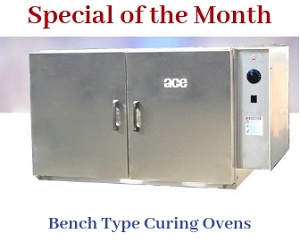Products
Pallet rack maker finds it’s better to burn-off in-house than outsource away
A manufacturer installs a burn-off oven to improve production efficiencies, reduce operating costs, and boost its powder coating capabilities. What’s more, the oven paid for itself in 6 months.
Los Angeles-based Hannibal Industries has a tubular division that makes steel tubing and a material handling division that manufactures pallet rack. The material handling division supplies distributors and direct retail, such as Home Depot. The racking is made from a light gauge, roll-formed steel or a heavy-duty structural steel. Hannibal performs its own roll forming. After receiving steel coil directly from the steel mills, the tubular division uses its splitting lines to split the coil to the specified widths. Then, the material handling division has six roll-form lines that convert the strip into either the beams or the columns for the pallet rack.
The company’s product line consists of standard size frames, lengths, and beams. These roll-formed frames can be set at whatever height the rack system demands. Beams span lengthwise between the frames and can be placed at different locations on the frames. The beams serve as shelves. The frames support the shelves. The modular system consists of either 42-inch or 48-inch- deep frames, from 12 feet to 35 feet tall. The structural pallet rack serves specific applications, such as warehouse operations where workers drive right in with the pallets or push-back racks, or use different sorts of pick modules customized to the warehouse and the material handling system. “The warehouse products are all meant to get better storage space out of your existing floor space,” said Travis Linds, operations manager.
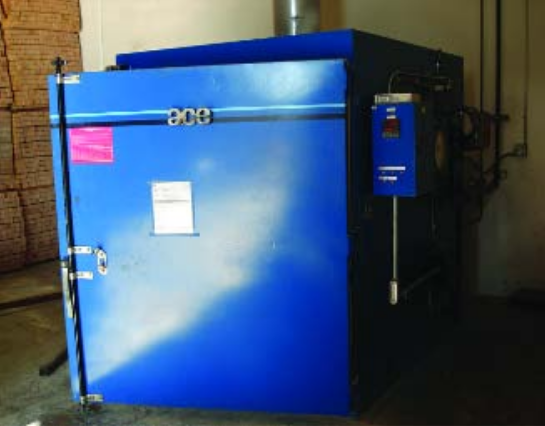
Hannibal Industries uses this burn-off oven to remove powder buildup from its hangers.
Applying powder provides strong foundation
Since the material handling division began in 2000, it has applied powder. At that time, Hannibal Material Handling bought a roll form company and a rack manufacturing company, and brought those operations to its LA location.
It also installed its powder line, which was designed into the plant’s original layout. Environmental issues and coating performance properties drove the company to choose powder. “We have pretty tight VOC (volatile organic compound) restrictions here,” Linds said. “Low VOCs are huge. [Powder] is also the preferred coating for pallet rack. It’s definitely far superior to any baked enamel or any wet paint application.”
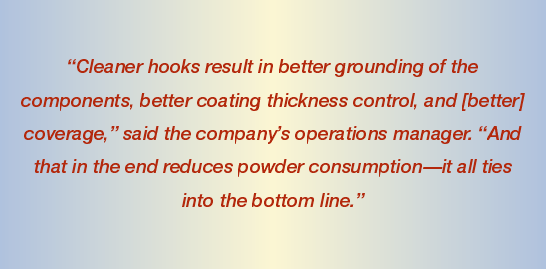
Typically, the line operates for two 8-hour shifts. Depending upon the volume, shifts can run as long as 0 hours. The system is run by 15 employees, including loaders and unloaders, powder booth operators, material handlers, and supervisors. Although hybrid powder coatings are used, the majority of parts get coated with triglycidyl isocyanurate (TGIC) based powder coatings. The company also applies an epoxy powder coating for specific food storage applications that use sulfur dioxide (SO2) gas. Health department regulations play a part in those applications. For example, in the San Francisco Bay area where vineyards store grapes on the company’s racks, the SO2 functions as a preservative for the fruit. The racks get washed down after the grapes are moved. Because water and SO2 can form sulfuric acid, which can quickly chew through the steel, powder aids in corrosion prevention and cleanliness. Hannibal Industries applies powder supplied by DuPont Powder Coatings, Houston, and Continental Industries, Tualatin, Ore. “We use 800,000 pounds of powder a year,” Linds said. “It’s a significant operation.”
Bringing burn-off capabilities in-house
Hannibal’s high production volume quickly left parts hangers with powder buildup. Previously, the hooks had to be sent out for cleaning; otherwise, grounding, powder adhesion, and film coverage suffered. The company outsourced burn-off to remove the buildup and then wash off the residue. Though burn-off was needed, outsourcing challenged operations and posed extra costs. “There were the logistics of getting them, loading them and sending them out, and having to get them back in time,” Linds said. “We had to have extra hooks.”
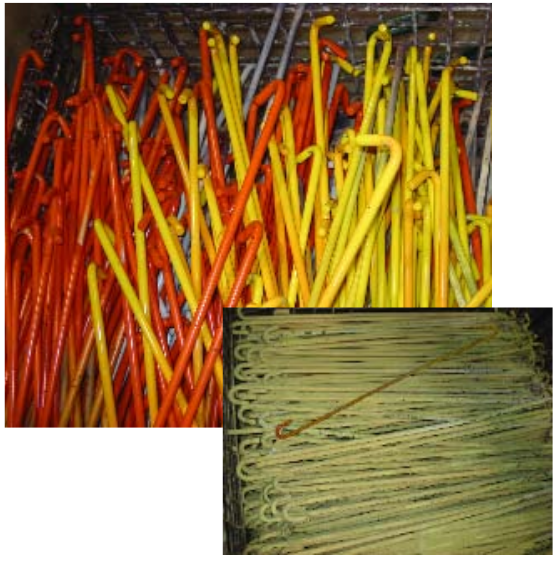
Line operator’s load hooks by the basketful into the oven. When the burn-off cycle is complete, a worker removes the ashy residue with a power washer.
To facilitate production and cut costs, the company considered bringing stripping capabilities in-house. As a result of the applied coating thickness, Linds thought that chemical stripping wasn’t feasible. From the research Linds and his staff did, they decided that a burn-off oven was an easy and standard method for removing powder: The Company considered two burn-off ovens. Ultimately, it decided to install a hybrid oven supplied by ACE Equipment, Cleveland. “We compared the costs of the oven and determined the oven paid for itself in 6 months,” Linds said. “It was a pretty no-brain payback equation.”
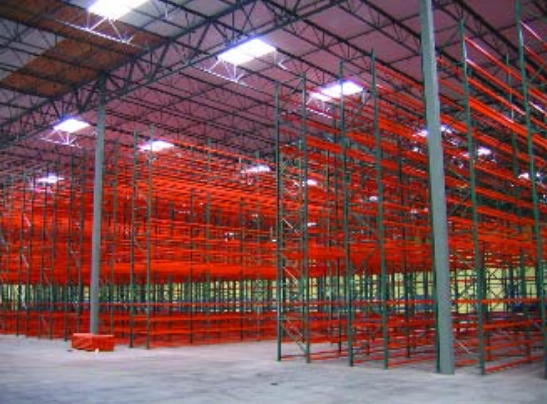
The company’s material handling division manufactures pallet rack, supplying distributors and direct retail, such as Home Depot.
The hybrid radiant tube burn-off oven operates at 93 percent efficiency and provides uniform heating to +/-10°F, eliminating hot or cold spots. The efficient burn-off system reduces natural gas consumption. The unit’s one-touch control system simplifies parts processing. After touching the button, the unit will detect the load, determine the time needed to strip coatings, and automatically shut down without programming or operator input. The oven combines infrared energy and radiant heat. Hannibal Industries uses the oven daily. “The cleaner we keep our hooks the better and more efficient our process is,” Linds said. “We try to run the hooks two to three coating cycles before burning, or, when we go from loading beams to frames, we won’t rehang the hooks until we burn them.”
Workers accumulate the coated hangers in large wire baskets, which are placed on a cart and rolled into the oven. Baskets are stacked on the cart to allow sufficient airflow to promote burn-off efficiency. Most of the time employees use forklifts to load the oven cart. The line supervisor is responsible for loading and operating the burn-off oven. The operator chooses from three preset programs depending on the load in the oven— small, medium, or large. The oven controls provide the flexibility to do other programs. To date, Hannibal hasn’t needed to use any additional burn-off program cycles.
Once the supervisor selects the program, a few checks confirm that the water spray is working properly and the oven closes. Override protection ensures that if the oven exceeds its temperature set points water spray will be activated to control the temperature and alleviate the chance of harmful combustion. The oven is also equipped with automatic shut down and an alarm. “What I like about it is that it is so simple, so trouble free,” Linds said. “We’ve had very few problems with it.”
In addition, the oven is equipped with an afterburner. The oven needs to reach a specific set point. Hannibal needed to get a permit that requires the afterburner to exceed the set point—1,010°F—to ensure there is total combustion of any byproducts. For every burn-off cycle performed, workers record the date, time, and temperature of the oven and the afterburner.
Racking up rewards
As a result of installing the burn-off oven, Hannibal Industries has reduced its operating costs. The elimination of outsourcing has represented a significant savings. Moreover, with burn-off capabilities in-house, workers keep cleaner hooks than when the company relied on outsourcing. As a result, the coating operation and product finish improved. In addition, Hannibal has been able to reduce its hook inventory, representing further operational savings. “Cleaner hooks result in better grounding of the components, better coating thickness control, and [better] coverage,” Linds said. “And that in the end reduces powder consumption— it all ties into the bottom line.”
Editor’s note
For further reading on the topics discussed in this article, see Powder Coating magazine’s Web site at [www.pcoating.com]. Click on Article Index and search by subject category. Have a question? Click on Problem solving to submit one. To receive the magazine’s weekly Q&A column via e-mail, scroll to the bottom of the home page and send us your e-mail address. The weekly column includes a reader advice section that allows you to offer ideas to readers’ questions.
Burn-off oven:
ACE Equipment, Cleveland. (216) 267-6366. www.armature coil.com
Powder coatings:
DuPont Powder Coatings, Houston. 713/939-4000. www.dupontpowder.com
Powder coatings:
Continental Industries, Tualatin, Ore. 503/692-3400. www.continentalcompanies.com.
